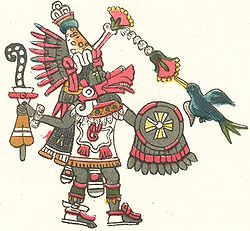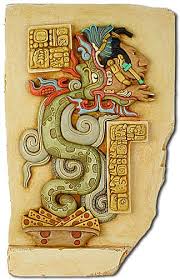Pierre Honoré
Honoré, Pierre
Pierre Honoré was the author of In Quest of the White God[956], which explored the legends that persisted among the natives of Central and South America of white pre-Columbian visitors, revered as gods, that had come from the east. Individual ‘gods’ were remembered as Kukulcan by the Maya and Quetzalcoatl by the Toltecs and Aztecs. Honoré proposed that these ‘deities’ had come from Crete and brought their script with them and since the use of Linear A & B ceased around 1400 BC, the transatlantic visits must have taken place before that date.
Honoré’s book was later republished as In Search of Quetzalcoatl, which can be read online(a). Unfortunately, Honoré’s work has been seen as racist and is often used now by white extremists.
Jason Colavito has delivered a characteristically harsh review of the ‘White Gods’ school of thought.(b)
Quetzalcoatl
 Quetzalcoatl is a Mesoamerican deity, whose name in the local Nahuatl language means ‘feathered serpent’. To the Aztecs he was a creator god and also had a parallel in Mayan culture to whom he was known as Kukulcan or Gucumatz.
Quetzalcoatl is a Mesoamerican deity, whose name in the local Nahuatl language means ‘feathered serpent’. To the Aztecs he was a creator god and also had a parallel in Mayan culture to whom he was known as Kukulcan or Gucumatz.
For some centuries it has been generally thought that the Aztec Emperor Moctezuma II initially believed that Hernán Cortés’ arrival to be the anticipated return of their deity Quetzalcoatl. The veracity of this story has come under increased attack, exemplified by a paper from Jordan Baker(b).
>>Michael MacRae in Sun Boat: Odyssey Deciphered [985] he identified Quetzalcoatl with Homer’s Odysseus.<<
It is a commonly held belief among Mormons that Quetzalcoatl was Jesus Christ!
More widespread and a little less contentious is the idea that St. Thomas the Apostle was Quetzalcoatl(e). “Within two decades of the Conquest, Quetzalcoatl was identified with St. Thomas, the wandering apostle. Since that time Quetzalcoatl has been described as a Viking, a Chinese Explorer, an extraterrestrial, Moses, and Jesus Christ. Similarly, most Mormons assume that the legends of Quetzalcoatl were simply distorted reminiscences of the visit of Christ to the New World as detailed in the Book of Mormon”(f).
An Indian website vehemently disputes the association of St. Thomas with Quetzalcoatl and for good measure also argues against the idea of St. Thomas in India!(g)
Harold T. Wilkins claimed [363.97] that Quetzalcoatl was from Atlantean Brazil.
Pierre Honoré claimed[0956] that these white gods had come from the region of Crete and had brought with them their script. As Linear A & B had both ceased being used by 1400 BC, Honoré surmised that visits of these deities had taken place before that date.
Lewis Spence also claimed an Atlantis connection for Quetzalcoatl, identifying the Mesoamerican deity as Atlas.
>>Gene D. Matlock has proposed that Quetzalcoatl had arrived in Mexico from India(h).<<
Daniel Fleck had some interesting thoughts on Quetzalcoatl(c).
Christian O’Brien has proposed that Quetzalcoatl had been one of the Sages who originated in Sumeria and travelled the world spreading advanced knowledge, including astronomy and megalith building [1797.117]!
In 1900 Peter de Roo concluded, “that Quetzalcoatl was a Christian prelate who landed in America, accompanied by several inferior missionaries and a number of people from some part of Christian Europe, and that he established a settlement in the territories of the Mexican empire or, perhaps, on the eastern coasts of our United States, from whence they eventually extended their race and religion along the Mexican Gulf.” [890+.1.582]
These ideas are just pure conjecture but are relatively tame compared with the wilder speculations of writers such as Peter Kolosimo, who “claimed that the legends actually describe a race of white men who were born in spaceships and migrated to Atlantis; then after Atlantis was destroyed, they moved to the Americas to be treated as “white gods” by the “primitive earth-dwellers.”(a)
[890.1.]+ https://archive.org/details/historyamericab02roogoog vol.1
(a) https://en.wikipedia.org/wiki/White_gods
(b) The Real Story of the ‘Bearded God’ Named Quetzalcoatl | Ancient Origins (ancient-origins.net)
(e) http://gnosis.org/thomasbook/ch20.html
(f) https://sunstone.org/wp-content/uploads/sbi/articles/055-06-10.pdf
Kukulcan
Kukulcan was the ‘feathered serpent’ god of the Mayan religion. He also had a human form that  closely matches a description of a tall Caucasian, white-skinned, blue-eyed with blonde or silver hair. This similarity led to the European invaders being initially greeted as ‘gods’. There have been frequent suggestions that the original Kukulcan was a survivor of the demise of Atlantis, who managed to escape to Mesoamerica bringing the knowledge of the lost city to the Americas. However, it must be stressed that this is only conjecture. The Aztecs and Toltecs had a similar god, Quetzalcoatl, who had a matching description.
closely matches a description of a tall Caucasian, white-skinned, blue-eyed with blonde or silver hair. This similarity led to the European invaders being initially greeted as ‘gods’. There have been frequent suggestions that the original Kukulcan was a survivor of the demise of Atlantis, who managed to escape to Mesoamerica bringing the knowledge of the lost city to the Americas. However, it must be stressed that this is only conjecture. The Aztecs and Toltecs had a similar god, Quetzalcoatl, who had a matching description.
Pierre Honoré claimed that these ‘deities’ had arrived from Crete bringing with them their script. As the use of the Cretan Linear A & B had ceased by 1400 BC Honoré surmised that these transatlantic trips took place before that date!
Cuchulainn, an Achilles type hero in Irish mythology, has also been speculatively linked with Kukulcan because of the name similarity, an idea that has never had any scholarly support.>So it was no surprise that the unreliable Xavier Séguin supported this silly idea(a). Even Philip Gardiner seems to have been seduced by this linkage, noting in The Serpent Grail “that the Irish have a Celtic god-hero named Cuchulainn, which is too similar to the Mayan Kukulcan to be mere coincidence.”<
(a) https://www.irishcentral.com/roots/history/irish-hero-cu-chulainn-was-a-mayan-god *
